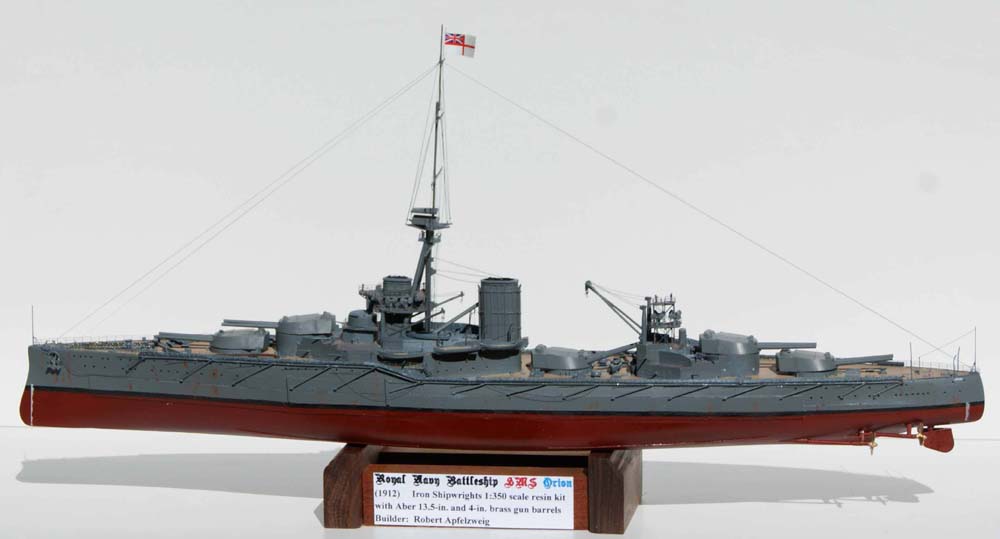
1/350 HMS Orion 1912 (ISW)
|
by Robert Apfelzweig |

1/350 HMS Orion 1912 (ISW)
HMS Orion was the first of a class of superdreadnoughts, being the first warship to mount the new 13.5-in 45 cal. heavy gun and the first British battleship with an all center-line main armament. For some reason the Royal Navy reverted to earlier practice, begun with HMS Dreadnought, of mounting the heavy foremast spotting top immediately behind and above the forward funnel, so that the coal-fired boiler exhaust would make its manning almost impossible without top speed operation or a strong headwind. Like much of Great Britainís Grand Fleet, the Orion fought at the Battle of Jutland, without suffering any damage, but saw little other action during the war and was scrapped in the early 1920ís under the terms of the Washington Naval Treaty of 1921.
ISWís resin kit is typical of their models of the past decade, with a generally well-cast hull and deck equipment but excessive overpour and pitting on the keel, though nothing that canít be fixed with putty and sanding. The extensive photoetch fret provides insufficient 3-bar railing for the main and quarter decks, and the 13.5-in. and 4-in. gun barrels (especially the latter) are highly variable in quality; I used Aber brass barrels, but only had eight of the large ones, so I took two of the best resin barrels for the middle, or Q, turret. The kitís one major engineering flaw is that the barbette for Q turret is positioned too far aft (by about a quarter of an inch), so that the 13.5-in. barrels must be shortened significantly to fit them into the available space between the rear bridge and the turret face (and I maximized their length by elevating the barrels somewhat). The kit includes round and square photoetch spacers for the radio antennas that would have been mounted between the bow and stern and suspended from the top of the foremast, but although the instructions show how to assemble them, in practice (at least using stretched black sprue for rigging, as I always do), the results I obtained were so unsatisfactory that I abandoned the attempt to show any four-cable antennas altogether. The port and starboard tripod struts also did not fit well into the bridge assembly, despite widening their deck holes, with the result that they bent slightly inward when attached to the vertical strut. The Orionís assembly instructions are typical of ISW, with hand-drawn diagrams, but are more detailed than I have seen with several of their previous kits in this scale. ISW provides both straight brass rods and warped resin versions for the masts, and narrower brass rods for the yardarms.
The instructions state that this is the 1916 version of the Orion, hence
no antitorpedo net apparatus is provided, but then neither is the 4-in.
AA gun that would have been placed on the quarterdeck; I chose to model
the ship as she would have looked soon after her commissioning in 1912,
and used 0.75-in. Evergreen plastic rods for the net booms and round shoelaces
for the rolled up nets. ISW provided no anchor chain and so
I used some from a Fujimi battleship kit I have yet to build. Choosing
a suitable grey paint is always an issue with warships of this era; I used
Tamiya Ocean Grey (RAF) in both spray can and acrylic liquid form, Tamiya
Deck Tan for the decks (and a mixture of Hull Red and Sky Grey for the
corticene decks in the superstructure), water-based spray Liquitex Cadmium
Red Hue for the lower hull and Model Master flat black for the boot topping
and funnels. Iíd also like to acknowledge the assistance of Dave
Baker and Simon Scheuer from Steelnavy.net for pointing out that the small
platform atop the rear bridgeís searchlight platform held a compass and
binocular rangefinder, which I scratchbuilt (the kit instructions showed
nothing up there).
